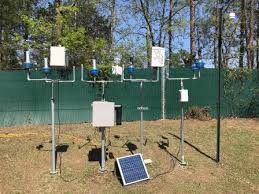Continuous Emission Monitoring SystemsPosted by Radmin on July 21st, 2019
In industrial processes oftentimes emissions directed into the environment are necessary. To be good environmental stewards, companies are required to work with the U.S. Environmental Protection Agency (EPA) and state offices of the EPA to stay within compliance ranges for acceptable levels of emissions to be released into the environment. To help make this a smooth process, continuous emission monitoring systems (CEMS) are put in place. These CEMS operate 24/7 utilizing the latest technology to monitor, analyze, and report on the chemical composition of emissions. In turn, this ensures that companies are not unknowingly harming the environment, as well as protecting the health and safety of the public. Extractive and Dilution CEMSThere are two types of CEMS in terms of how samples are taken. A full extractive CEMS continuously takes a sample from an emission stream. Then it passes the sample through a heated filter head and onto a condenser. The condenser removes moisture so the analyzer can take a more accurate reading. A dilution extractive CEMS continuously draws a sample from an emission stream but dilutes the sample with an infusion of air. Then the diluted sample is set through an ambient level gas analyzer for an accurate reading. Different Types of CEMSOne type of CEMS are Continuous Opacity Monitoring Systems known as COMS. These monitoring systems measure the amounts of particles mixed in with the emissions being released into the environment. COMS employ an optical head and reflector to sample emissions. Then signals from the system are sent to a data recorder which generates a report. Continuous Emissions Rate Monitoring Systems (CERMS) measure the volume of the flow emissions, or how much is being released into the environment. An example would be the rate of exhaust gases being sent through a duct or stack. Gaseous Continuous Emissions Monitoring Systems (GCEMS) measure the composition of the gases being emitted into the environment. Third-Party CEMS CompaniesSometimes smaller companies with emissions coming from their manufacturing facilities will outsource the measurement and reporting of their emissions. CEMS companies are experts in the Environmental Protection Agency emissions regulations and know where a company needs to be in terms of their emissions outputs to be considered in compliance with federal and state regulations. These outside companies will spend the time to understand the company’s manufacturing processes and design and install the right CEM systems. Then through software and the internet, the third-party company will monitor and record levels to ensure the manufacturing company is compliant with all daily, weekly, monthly, quarterly, or annual reporting. Continuous emission monitoring systems are helping company be good environmental stewards, staying well with in emission compliance limits set by the U.S. Environmental Protection Agency (EPA) and state offices of the EPA. Like it? Share it!More by this author |



